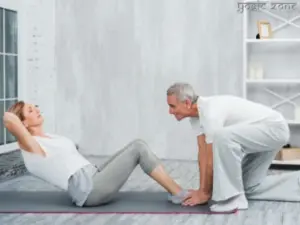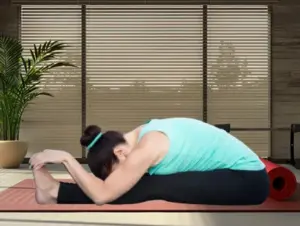
Certified yoga instructor with 900+ hours training from The Yoga Institute, Mumbai | Hatha & Ashtanga specialist | Workshop leader | Focus on strength, stress relief, holistic wellness. Know more about Drishti Joshi.
The journey to yoga often begins with a single step—or in this case, a single, mindful breath. If you have been thinking about a routine that offers both physical strength and deep mental calm, then Hatha Yoga for beginners is the right choice.
I am a qualified trainer and teach Hatha & Ashtanga Yoga, among other skills. I will share my simple guide to Hatha yoga for beginners, an ancient path that truly stands the test of time.
What is Hatha Yoga?
Traditional Hatha Yoga is the foundation for most modern styles and remains a beautiful, slow, deliberate, and accessible practice today. The word ‘Hatha’ comes from Sanskrit: ‘Ha’ symbolizes the sun (active/masculine energy) and ‘Tha’ the moon (receptive/feminine energy).
Hatha Yoga is the yoga of balance, aiming to harmonise the opposites within us. By using physical techniques and mindful breath, Hatha purifies both body and mind—preparing us for deeper meditation and personal growth.

The Five Steps of Traditional Hatha Yoga
While ancient texts like the Hatha Yoga Pradipika offer detailed guidance, I like to focus on five core elements that any beginner can master:
- Shatkarma/Kriyas: These are ancient cleansing or purification techniques for the internal organs. While some are advanced, even simple breathing exercises like Kapalbhati are considered Kriyas that cleanse the respiratory system and energise the body.
- Asanas: This is the physical practice most people associate with yoga. Hatha yoga asanas are held for longer periods to build stability, strength, and awareness.
- Pranayama (Breath Control): The deliberate regulation of breath (or prana, the life force) to clear the energetic channels (nadis) and steady the mind. This is a powerful tool for calm.
- Mudras (Gestures) and Bandhas (Energy Locks): These are techniques used to manipulate and lock prana within the body, steering the energy flow toward higher consciousness.
- Dhyana (Meditation): The ultimate goal is to lead the purified body and focused mind toward a state of single-pointed concentration and deep meditation.
Do you have any doubts or questions about this article?? I am Drishti Joshi, the author, and I would love to hear from you. Send us your question now!
Hatha Yoga for Beginners: Simple Asanas to Start With
As a beginner, you don’t need to worry about flexibility or advanced postures. The core of Hatha yoga for beginners lies in mastering the fundamentals and connecting movement with breath.
Here are a few beneficial hatha yoga asanas; I highly recommend including them in your routine. Remember, the focus is on stability and holding the asana with mindfulness, not just getting into the shape. Read our blog to know the benefits of the different types of yoga.
| Asana Name | Key Benefits |
|---|---|
| Tadasana (Mountain Pose) | Promotes good posture, strengthens thighs and ankles, grounds and stabilises the body |
| Vrikshasana (Tree Pose) | Improves focus, concentration, stability; strengthens legs; teaches stillness in chaos |
| Bhujangasana (Cobra Pose) | Opens the chest, strengthens the spine, relieves mild stress and fatigue; ideal if you have a desk jobs |
| Adho Mukha Svanasana (Downward-Facing Dog) | Full-body strengthening and stretching; decompresses spine, calms nervous system |
| Paschimottanasana (Seated Forward Bend) | Stretches hamstrings, spine, shoulders; reduces stress/anxiety; promotes inner peace |
Note: The asanas mentioned here are recommended by our qualified and experienced authors for general awareness and inspiration. We do not provide step-by-step instructions, as each individual’s physical condition and needs are unique. We strongly recommend learning yoga under the guidance of a qualified instructor who can offer personalised support and ensure safe practice.
The Lasting Hatha Yoga Benefits
Consistent Hatha practice brings profound physical, mental, and emotional improvements. I have witnessed better posture, reduced stiffness, and noticeably increased strength and flexibility in my own journey and my students.
Mentally, the discipline of staying present in each pose gradually silences inner chatter and allows you to respond to life with calmness. Regular practice is also known to help regulate the nervous system, a powerful tool for managing anxiety.
Frequently Asked Questions: Hatha Yoga For Beginners
I am sharing with you some of the most common questions I am asked by my beginner yoga students. If you have also wondered about these, you’re not alone!
I am not flexible—can I still do Hatha Yoga?
Absolutely! Hatha yoga is recommended for everyone. Most of my students could not touch their toes when they started. Asanas can always be modified; progress comes with patience and practice. Mindfulness matters more than ‘perfect’ form.
How do I stay consistent with yoga practice?
I recommend setting achievable goals—try three sessions per week for just fifteen minutes. Find a supportive group or set gentle reminders. Just showing up, regularly, makes all the difference.
My back hurts during asanas—am I doing it wrong?
Pain usually means something needs adjusting. Stop! Check your alignment, and don’t practice if in pain. I always tell beginners: listen to your body. Try using props, modify poses, and seek guidance if needed. Safety is more important than depth. Understand how yoga props help beginners.
Is it normal to feel tired after yoga?
Definitely! Hatha yoga engages both body and mind in new ways. Tiredness after practice shows your body is adapting and building resilience. Rest, have some water, and soon you will notice renewed energy and improved strength.
Your Hatha Yoga for Beginners Journey Starts Now
If you want a disciplined yet gentle way to improve your health, I urge you to begin with Hatha Yoga for beginners. Start slow, focus on your breath more than the poses, and remember: consistency wins over intensity. This ancient wisdom is not just about posture—it’s about living in balance, finding strength in stillness, and peace in movement.
Take that first step onto the mat. Your journey to a calmer, stronger you starts today.
Do you have any doubts or questions about this article?? I am Drishti Joshi, the author, and I would love to hear from you. Send us your question now!



